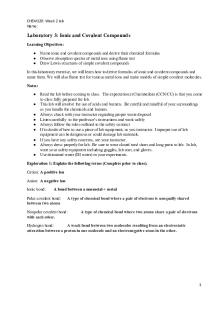Chapter 3 Nomenclature for ionic and covalent compounds PDF

| Title | Chapter 3 Nomenclature for ionic and covalent compounds |
|---|---|
| Author | Athia Zaman |
| Course | gen chem |
| Institution | St. Cloud State University |
| Pages | 3 |
| File Size | 98.1 KB |
| File Type | |
| Total Downloads | 14 |
| Total Views | 146 |
Summary
Download Chapter 3 Nomenclature for ionic and covalent compounds PDF
Description
Nomenclature for Ionic and Covalent Compounds What do you call it? There are two sets of rules for naming simple, inorganic compounds: one for ionic compounds and another for covalent compounds. So the first task is to identify which type of compound you’re dealing with.
NaBr sodium bromide MgF2 magnesium fluoride K2O potassium oxide Ca3N2 calcium nitride Na2SO4 sodium sulfate FeCl2 iron(II) chloride Fe(OH)3 iron(III) hydroxide NH4Cl ammonium chloride (NH4)2SO4 ammonium sulfate Table 1 The formulas and names for some ionic compounds.
CO carbon monoxide CO2 carbon dioxide CCl4 carbon tetrachloride XeF6 xenon hexafluoride N2O3 dinitrogen trioxide N2O5 dinitrogen pentoxide H2O water Table 2 The formulas and names for some covalent compounds
1. Ionic compounds often form between a metal and a nonmetal. Five of the compounds in table one meet this definition. For each, please complete the following table. One has been done to serve as a model. Formula MgF2
The metal ion(s). Mg2+
The non-metal ion(s). 2 F-
2. The remaining four ionic compounds all have at least on polyatomic ion. Please complete the following table. Formula The cation The anion SO42Na2SO4 2 Na+
5. Discuss with your team how you can tell from the formula for FeCl2, that the iron must have a +2 charge. Write your consensus explanation.
This section only covers binary covalent compounds, those molecules composed of two elements. Covalent compounds do not have ions. The charges you have learned from the periodic table, and the formulas for the polyatomic ions do not apply. Instead the name of a covalent compound simply tells the number of atoms. 6. Using the information in table 2, make a list of prefixes used to name binary covalent compounds and the numbers to which they correspond.
Going from a formula to a name. For ionic compounds, you simply name ions, cations first. For elements which can have multiple charges, the charge is indicated with Roman numerals. For covalent compounds you again put the most positive element first followed by the more negative element which will have –ide as its ending. The number of atoms of each element in the compound is indicated with prefix; however, the prefix mono is not used to for the first element, for example CO is named carbon monoxide, not monocarbon monoxide. Going from a name to a formula. Getting the formula for a covalent compound is relatively easy to determine because the name of the compound will tell you the number of each atom there. To generate the formula for an ionic compound you need to know the charges of both the cation and the anion. The charge of the cation will become the number of anions needed, and the charge of the anion will become the number of cations. Finally the subscripts need to be reduced to the smallest whole number ratio. If you’ve done this right the compound is electrically neutral. Example: Write the formula for iron(II) phosphate. 1. Write the formulas for the ions:
Fe2+ PO43-
2. The cation charge becomes the number of anions, and the anion charge becomes the number of cations. Fe3(PO4)2 3. This is good because the +6 charge from the 3 irons ions is canceled by the -6 charge from the two phosphates ions. 7. Taking turns, name the following: a. BaCl b. NH4F c. P2S5 8. Taking turns, give the formulas for the following: a. Potassium iodide. b. Nitrogen tribromide. c. Sodium carbonate.
phosphate hydrogen phosphate sulfate carbonate bicarbonate (hydrogen carbonate) dihydrogen phosphate acetate nitrate hydroxide hydrogen ion hydronium ammonium Table 3 Some polyatomic ions.
PO43HPO42SO42CO32HCO3H2PO4CH3CO2NO3OHH+ H3O+ NH4+
Adapted from Garoutte and Mahoney. General, organic, and biological chemistry: a guided inquiry. 2nd ed., Wiley, 2014....
Similar Free PDFs

Covalent and Ionic Compounds
- 5 Pages

SCHU4U1 Ionic Covalent lab
- 9 Pages

Ionic and covalent bond lab
- 1 Pages

05 - Ionic Compounds Worksheet
- 4 Pages
Popular Institutions
- Tinajero National High School - Annex
- Politeknik Caltex Riau
- Yokohama City University
- SGT University
- University of Al-Qadisiyah
- Divine Word College of Vigan
- Techniek College Rotterdam
- Universidade de Santiago
- Universiti Teknologi MARA Cawangan Johor Kampus Pasir Gudang
- Poltekkes Kemenkes Yogyakarta
- Baguio City National High School
- Colegio san marcos
- preparatoria uno
- Centro de Bachillerato Tecnológico Industrial y de Servicios No. 107
- Dalian Maritime University
- Quang Trung Secondary School
- Colegio Tecnológico en Informática
- Corporación Regional de Educación Superior
- Grupo CEDVA
- Dar Al Uloom University
- Centro de Estudios Preuniversitarios de la Universidad Nacional de Ingeniería
- 上智大学
- Aakash International School, Nuna Majara
- San Felipe Neri Catholic School
- Kang Chiao International School - New Taipei City
- Misamis Occidental National High School
- Institución Educativa Escuela Normal Juan Ladrilleros
- Kolehiyo ng Pantukan
- Batanes State College
- Instituto Continental
- Sekolah Menengah Kejuruan Kesehatan Kaltara (Tarakan)
- Colegio de La Inmaculada Concepcion - Cebu











